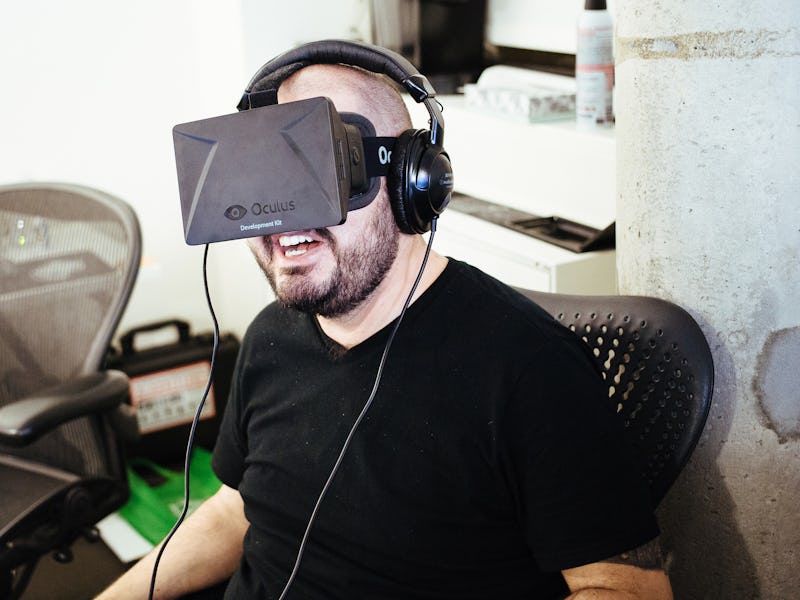Proving 'Palmer Luckey's Law': The Better a VR Setup Works, the Dumber it Looks
You can walk though VR, as long as you don't mind looking dorky.

Virtual reality gear is goofy. The world was recently reminded of this when Mark Zuckerberg gave a presentation to a room full of visored oxford shirts, but this is something we already know. The proof? When Palmer Luckey, the Oculus Rift founder who has described his tech as “👌👀👌👀👌👀👌👀👌👀 good shit go౦ԁ sHit👌 thats ✔ some good👌👌shit right👌👌th 👌 ere👌👌👌 right✔there ✔✔👌👀👌👀👌👀👌👀👌👀 good shit go౦ԁ sHit👌 thats ✔ some good👌👌shit right👌👌th 👌 ere👌👌👌 right✔there ✔✔,” appeared on the cover of Time he looked like a damn doofus. Palmer Luckey isn’t a doofus. He’s a brilliant young guy. But strap an Oculus rig on anyone short of Prince and they will look dumb.
Let’s call it “Palmer Luckey’s Law”: The better a virtual reality setup works, the more ridiculous the person using it looks.
Magnify the bulky Tron-reject snowboard goggles to something that allows you to walk in VR, and you end up rigged to a machine that belongs in H.R. Giger’s rec room. But if you want to hike through unreality, these devices are the nearest-term holodeck solution we’ve got. Here are perhaps the world’s best virtual reality setups.
They are awesome and boy do the people using them look dumb.
1. The Cyberith Virtualizer
The Virtualizer, like many omni-directional VR treadmills, comes with a torso cinch to keep you from strolling blindly off the edge. No one has ever enjoyed yelling at an onscreen character like this guy playing Skyrim, though he can’t swing his arms below the belt. The Virtualizer had a successful Kickstarter in 2014, but has since run into some production hitches.
2. The Reality Suspender
The prototype Reality Suspender ditches the treadmill for a hanging harness — you’ve got more freedom to move, but to travel long distances you’ll have to run/bunny hop in place.
3. VirZoom
Pitched as exercise plus entertainment, the $400 VirZoom bike lets you straddle a pegasus and pedal your way to untold heights. The demo graphics may be lackluster, and a few users have mentioned the potential for vertigo, but combination of motion sensors and biking results in a surprisingly realistic feeling of gliding on a winged horse.
4. The Virtusphere
The Virtusphere is a giant hamster ball that requires someone else to close you in. That’s all you really need to know.
5. The Infinadeck
If you smashed the Reality Suspender harness into the Virtualizer, and then built a device out of the pieces, it might not look like the Infinadeck, but you’d capture the general spirit. At 500 pounds, the Infinadeck is a hefty piece of machinery; early reviews positively point to a fairly natural gait — something other omni-directional treadmills struggle to facilitate — but the current size means a focus on military and industrial markets.
6. The Virtuix Omni
Like the Virtualizer, the Virtuix Omni’s girdle means you have to run arms akimbo like a hunched-over robot. The Omni is one of the closest peripherals to market, with the pre-orders open now for the $699 treadmills. Because it relies on sensors in the pad, like all popular VR treadmills, movement requires footsteps that aren’t quite what evolution intended — the feeling is summed up by one reviewer as moonwalking in bowling shoes.
7. The DIY Treadmill.
Why unload lots of cash on a plastic and fiberglass frame when you can just make your own out of wood, carpet, and bungee cords?